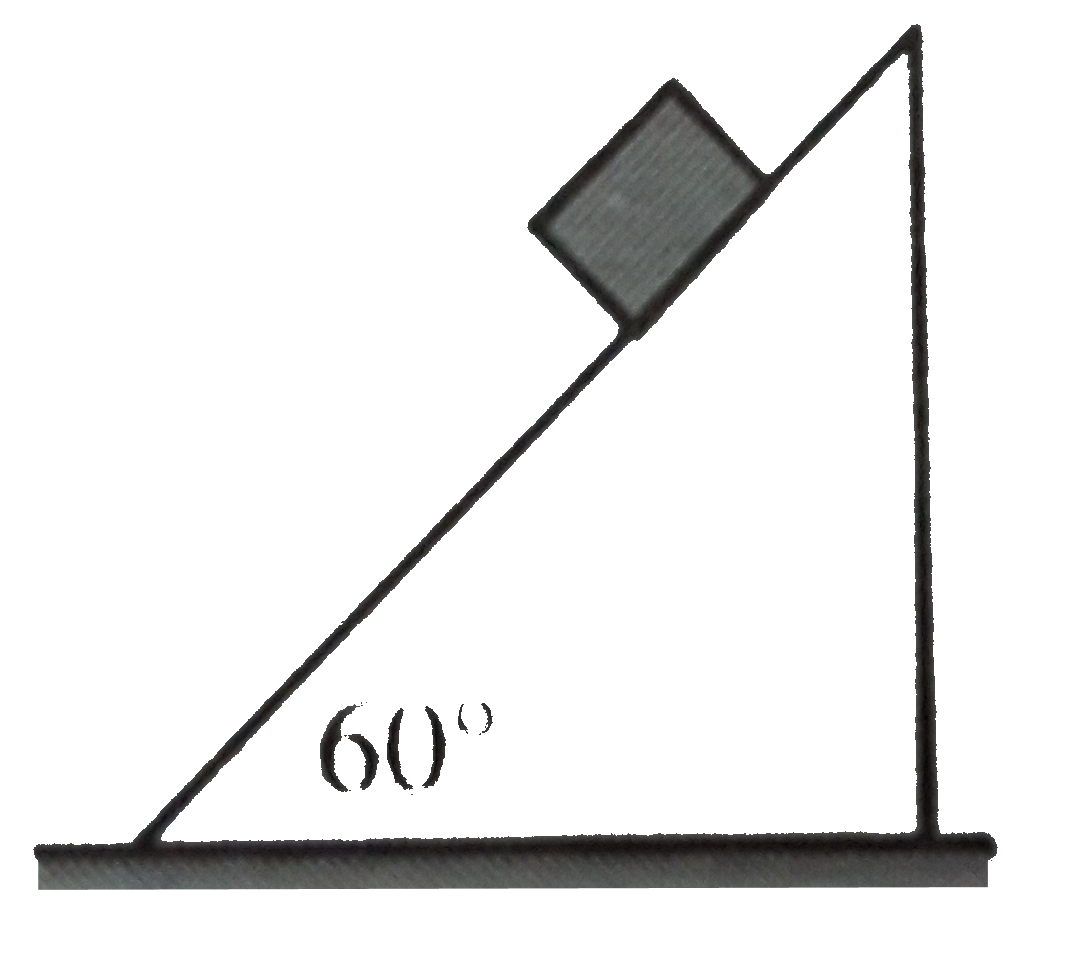A block is moving on an inclined plane making an angle 45∘ with the horizontal and the coefficient of friction is μ. The force required to just push it up the inclined plane is 3 times the force required to just prevent it from sliding down. If we define N=10μ, then N is
The correct Answer is:5
To solve the problem step by step, we will analyze the forces acting on the block on the inclined plane and derive the necessary equations.
Step 1: Identify the forces acting on the block
On an inclined plane at an angle θ (45 degrees in this case), the forces acting on the block include:
- The gravitational force (mg) acting downward.
- The normal force (N) acting perpendicular to the surface of the incline.
- The frictional force (f) acting parallel to the incline, opposing the motion.
Step 2: Resolve the gravitational force
The gravitational force can be resolved into two components:
- Parallel to the incline: mgsinθ
- Perpendicular to the incline: mgcosθ
Since θ = 45 degrees, we have:
- sin45∘=cos45∘=1√2
Step 3: Write the equations for the forces
1. Force required to just push the block up the incline (F1):
F1=mgsinθ+f
where f=μN and N=mgcosθ.
Thus, substituting for f:
F1=mgsinθ+μ(mgcosθ)
2. Force required to just prevent the block from sliding down (F2):
F2=mgsinθ−f
Again substituting for f:
F2=mgsinθ−μ(mgcosθ)
Step 4: Set up the relationship between F1 and F2
According to the problem, F1=3F2. Substituting the expressions for F1 and F2:
mgsinθ+μ(mgcosθ)=3(mgsinθ−μ(mgcosθ))
Step 5: Simplify the equation
Cancelling mg from both sides (assuming mg≠0):
sinθ+μcosθ=3(sinθ−μcosθ)
Expanding the right side:
sinθ+μcosθ=3sinθ−3μcosθ
Step 6: Rearranging the equation
Rearranging gives:
μcosθ+3μcosθ=3sinθ−sinθ
This simplifies to:
4μcosθ=2sinθ
Step 7: Substitute θ = 45 degrees
Since sin45∘=cos45∘=1√2:
4μ(1√2)=2(1√2)
Cancelling 1√2 from both sides:
4μ=2⟹μ=12
Step 8: Calculate N
Given N=10μ:
N=10×12=5
Final Answer
Thus, the value of N is 5.
On an inclined plane at an angle θ (45 degrees in this case), the forces acting on the block include:
- The gravitational force (mg) acting downward.
- The normal force (N) acting perpendicular to the surface of the incline.
- The frictional force (f) acting parallel to the incline, opposing the motion.
The gravitational force can be resolved into two components:
- Parallel to the incline: mgsinθ
- Perpendicular to the incline: mgcosθ
- sin45∘=cos45∘=1√2
1. Force required to just push the block up the incline (F1):
F1=mgsinθ+f
where f=μN and N=mgcosθ.
F1=mgsinθ+μ(mgcosθ)
F2=mgsinθ−f
Again substituting for f:
F2=mgsinθ−μ(mgcosθ)
According to the problem, F1=3F2. Substituting the expressions for F1 and F2:
mgsinθ+μ(mgcosθ)=3(mgsinθ−μ(mgcosθ))
Cancelling mg from both sides (assuming mg≠0):
sinθ+μcosθ=3(sinθ−μcosθ)
Expanding the right side:
sinθ+μcosθ=3sinθ−3μcosθ
Rearranging gives:
μcosθ+3μcosθ=3sinθ−sinθ
This simplifies to:
4μcosθ=2sinθ
Since sin45∘=cos45∘=1√2:
4μ(1√2)=2(1√2)
Cancelling 1√2 from both sides:
4μ=2⟹μ=12
Given N=10μ:
N=10×12=5
Thus, the value of N is 5.
Topper's Solved these Questions
- NEWTON'S LAWS OF MOTION 2Book:CENGAGE PHYSICS ENGLISHChapter:NEWTON'S LAWS OF MOTION 2Exercise:Assertion -reasoning
Explore 2 Videos
- NEWTON'S LAWS OF MOTION 1Book:CENGAGE PHYSICS ENGLISHChapter:NEWTON'S LAWS OF MOTION 1Exercise:Integer
Explore 5 Videos
- PROPERTIES OF SOLIDS AND FLUIDSBook:CENGAGE PHYSICS ENGLISHChapter:PROPERTIES OF SOLIDS AND FLUIDSExercise:INTEGER_TYPE
Explore 2 Videos
Similar Questions
A block slides down an inclined plane that makes an angle θ with the horizontal. If the coefficient of kinetic friction is μ, find the acceleration of the block.
View SolutionA block slides down on inclined plane (angle of inclination 60∘ ) with an accelration g/2 Find the coefficient friction

View Solution
Knowledge Check
A block of mass 3 kg rests on a rough inclined plane making an angle of 30∘. With the horizontal. The coefficient of static friction between the block and the plane is 0.7. The frictional force on the block is
A9.8 NB0.7×9.8×√3 NC9.8×√3 ND0.7×9.8 N
A brick of mass 2kg begins to slide down on a plane inclined at an angle of 45∘ with the horizontal. The force of friction will be
View SolutionA block of mass m slides down an inclined plane which makes an angle θ with the horizontal. The coefficient of friction between the block and the plane is μ. The force exerted by the block on the plane is
View SolutionA block of mass m is lying on an inclined plane. The coefficient of friction between the plane and the block is μ. The force (F1) required to move the block up the inclined plane will be:-
View SolutionA block rests on a rough inclined plane making an angle of 30∘ with the horizontal. The coefficient of static friction between the block and the plane is 0.8. If the frictional force on the block is 10N, the mass of the block (in kg) is
View SolutionA block of mass 2 kg rests on a rough inclined plane making an angle of 30° with the horizontal. If μS=0.6 , what is the frictional force on the block ?
View SolutionA body of mass m is kept on an inclined plane . The force required to just move a body up the inclined plane is double the force required to just prevent the body from sliding down the plane. If the coefficient of friction is μ, what is the inclination of the plane ?
View SolutionA block is placed at the top of an inclined plane 5 m long. The plane makes an angle of 60∘ with the horizontal. If the coefficient of friction between the wood and the plane is 0.3, find the time taken by the block of slide down the bottom of the plane.
View Solution

